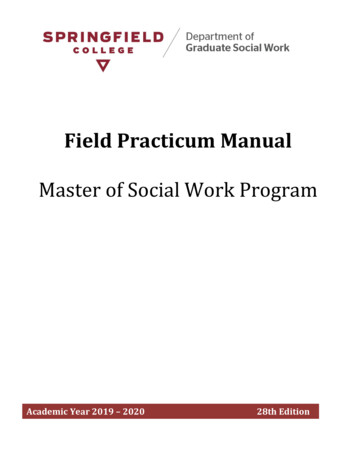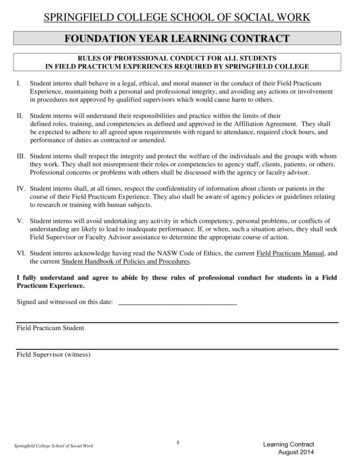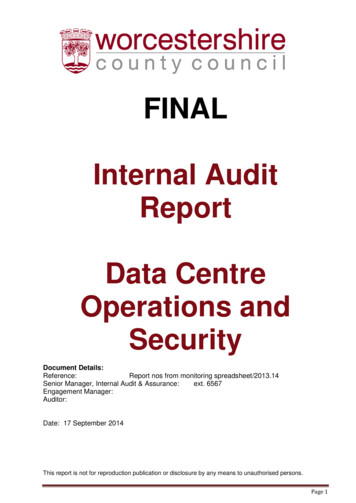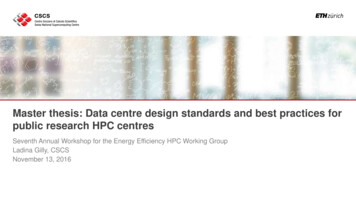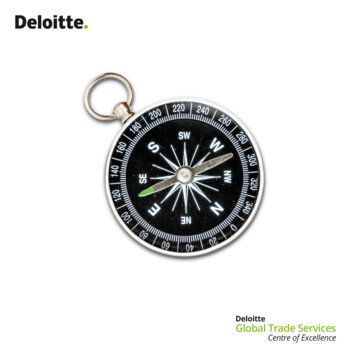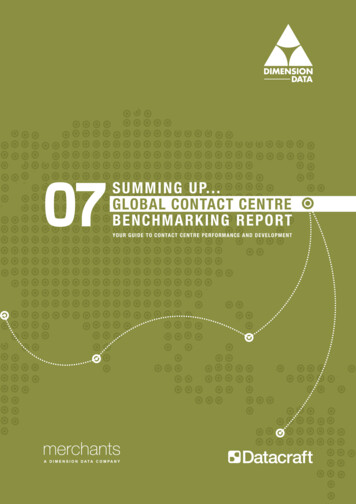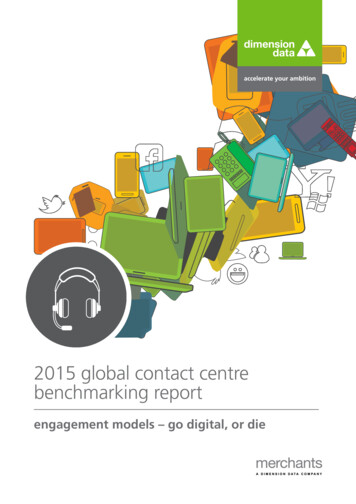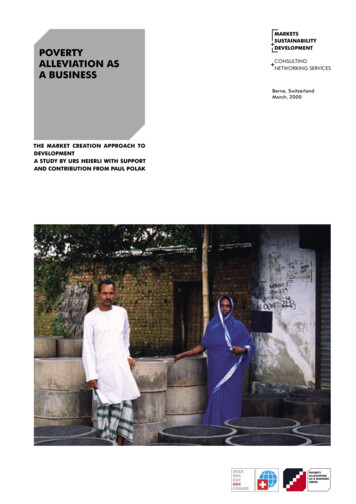
Transcription
POVERTYALLEVIATION ASA BUSINESSMARKETSSUSTAINABILITY DEVELOPMENTCONSULTINGNETWORKING SERVICES Berne, SwitzerlandMarch, 2000THE MARKET CREATION APPROACH TODEVELOPMENTA STUDY BY URS HEIERLI WITH SUPPORTAND CONTRIBUTION FROM PAUL POLAKPOVERTYALLEVIATIONAS A BUSINESSSERIES
Urs Heierli has been co-ordinator of SDC in Bangladesh andIndia from 1987-1999 and is now at the SDC head-office in Berne,Switzerland. He has written this study during a sabbatical periodbetween his two posting.Paul Polak is the founder and president of IDE, InternationalDevelopment Enterprises in Denver, USA. He has contributed tothis study in the conceptualisation of the market creation approachand with two annexes.Photo from the cover page: The creation of a market for treesand latrines has allowed this family in Bangladesh to provide useful products to poor people ; after being themselves below thepoverty line, they now run a nursery and a latrine production centreas a flourishing business.They are not an exceptional cases : in Bangladesh, there are 2500flourishing nurseries and 6000 private latrine producers. Urs Heierli, March 2000Designed by:Claudia DerteanoPublished by:SDC, Swiss Agency for Development and Co-operation,Division Industry, Vocational Training and Urban DevelopmentFreiburgstrasse 130CH - 3003 Berne/SwitzerlandFax : 41 31 323 08 49Email : msdconsult@swissonline.ch
POVERTYALLEVIATION ASA BUSINESSTHE MARKET CREATION APPROACH TODEVELOPMENTA STUDY BY URS HEIERLI WITH SUPPORTAND CONTRIBUTION FROM PAUL POLAKThis family near Indore ( India ) can grow 100 tomato plants with this bucket kit. They fill the bucket twice a day with water ; this is enoughto water the plants. Low cost drip irrigation saves up to 75 % of water ; in this area a litre of water costs almosta as much as milk.
AKNOWLEDGEMENTSTO MY DAUGHTERS MALA MAGDALENA AND LISALATIKAThis study is a synthesis of two working periods : 8 yearsat SKAT, the " Swiss Centre for Development Co-operationin Technology and Management ", from 1979 to 1987,and 12 years as co-ordinator of SDC in Bangladesh andIndia from 1987 to 1999. It tries to capitalise on thoseapproaches which have worked and which have showna large impact on poverty alleviation.I am very grateful to my predecessor in Bangladesh, ErwinBaenteli, for the hint he gave me during his handoverto me. I had asked him : " So many things have failed inthis country which Henry Kissinger had termed a "basketcase " ; so isn' t there anyhing which works ? " In reply, hesaid to me : " I think all those things which are driven bythe private initiative of the poor may work". How right hewas ! Nobody, at that time, would have dared believe thatprivate initiative taken by the poor could unfold the powerto make a million treadle pumps work, plant a 100 milliontrees or produce a million latrines every year – all beinga good business for the poor.I am very grateful to SDC for the 4 months of sabbaticalbetween my postings in India and in Berne, which allowed me to think about the " market creation approachto development " and to write down my thoughts. Thediscussions with many of my colleagues have helped meenormously to streamline these thoughts.I am extremely grateful for the hospitality of all the SDCoffices and SDC partners who have shown me their projects during my extensive field trips in the last monthsand who have answered all my questions with patienceand understanding.I am especially thankful to Paul Polak, the founder andpresident of IDE, for the extraordinary co-operation andhis contribution to this study ; sometimes daily exchangesby email or over the phone have given shape to this studyin many ways. The inspiring friendship we share over thelast 12 years is a gift of god for both of us. I would alsolike to thank the staff of IDE in Bangladesh, Nepal andIndia, especially Bob Nanes ; thanks to his ingenuity andperseverance we have so much to offer today.Finally, I would like to thank my wife Françoise for heroutstanding patience and the discipline, she showed inreviewing my texts, for her constant challenges to focusmy thoughts when they were confusing, and for myfamily 's understanding while doing this study.Urs Heierli ( Berne, March 2000 )5
TABLE OF CONTENTEXECUTIVE SUMMARY1.THE MARKET CREATION APPROACH TO DEVELOPMENT1.1. Introduction : Poverty alleviation as a business for the poor1.1.1. The conventional development approach1.1.2. The BDS approach for micro-enterprise promotion1.1.3. The market creation approach : poverty alleviating products made and sold as aprivate business1.2 The 4 Ps of marketing1.2.1. Product : more than just " hardware "1.2.2. Price : the art of pricing – what price quality ?1.2.3. Place : The supply channel1.2.4. Promotion : Creating awareness about the product1.3. Market creation and donor funding1.3.1. Obstacles in creating a market in favor of the poor1.3.2. Why does the private sector not create the markets on their own ?1.3.3. Phases of the product-cycle and effects over market creation1.3.4. The big kick which leads from introduction to maturation1.4. The performance of the market creation approach1.4.1. Impact and reach-out1.4.2. Good reasons for scaling up and bringing the approach into the mainstream1.4.3. Efficiency : very high returns on donor money1.4.4. Effectiveness : Can some products make a difference to the poor ?1.4.5. Market creation approach and poverty alleviation1.4.6. Sustainability and promotion : Partnerships with the corporate sector andwin-win 2324KEY ASPECTS OF THE MARKET CREATION APPROACH TO DEVELOPMENT2.1. Definition : what does it mean to create new markets ?2.2. Product development : products for the poor2.2.1. Background and Rationale2.2.2. The opportunities : " the machine culture " has not reached the poor( especially women )2.2.3. The challenge : to find other products, as good and suitable as the treadle pump2.2.4. The process : need-based, participatory R&D2.2.5. Best practices : guidelines for product development2.2.6. Optimising affordability must be a central part of the design process2.2.7. Example : the case of the " bucket kit " development in micro-irrigation2.3. Promotion and marketing2.3.1. Background and rationale2.3.2. How to inform conservative buyers : Seeing is believing2.3.3. The process : how to develop a promotion strategy2.3.4. What did IDE exactly do in Bangladesh ?2.3.5. Best Practices : guiding principles and the example of sanitation in Bangladesh2.4. Creating a market – how to go about it ?2.4.1. Background and rationale : Is there a market of the poor ?2.4.2. Why is the market of the poor underserved ?2.4.3. Forgotten consumer segments2.4.4. The poor as customers and entrepreneurs, instead of being recipients of charity2.4.5. Process : market research to understand needs2.4.6. Best practices : guiding principles and the example of Village Forestry in 31327Table of Content
3.SIX EXAMPLES OF EXISTING PROJECTS WITH A MARKET CREATION APPROACH3.1. Hundred million trees as a social insurance scheme : the village and farmforestry programme in Bangladesh3.1.1. Overview3.1.2. The marketing channel3.1.3. The 4 Ps of VFFP3.1.4. Outlook3.2. Pedalling out of poverty with the treadle pump in Bangladesh, India and Nepal3.2.1. Overview3.2.2. The marketing channel3.2.3. The 4 Ps of the treadle pump3.2.4. Outlook : the billion dollar question3.3. 60 kilograms more maize per family with " Postcosecha " silos in Central America3.3.1. Overview3.3.2. The marketing channel3.3.3. The 4 Ps of Postcosecha3.3.4. Outlook3.4. 2'000 micro-concrete roofing workshops produce 150'000 roofs per year3.4.1. Overview3.4.2. The marketing channel3.4.3. The 4 Ps of micro-concrete roofing tiles3.4.4. Outlook3.5. 6000 private workshops produce over a million latrines per year in Bangladesh3.5.1. Overview3.5.2. The marketing channel3.5.3. The 4 Ps of private latrine production3.5.4. Outlook3.6. The rope pump in Central America : the scope for private drinking waterpumps3.6.1. Overview3.6.2. The marketing channel3.6.3. The 4 Ps of the rope pump3.6.4. 7474949495050515152THE FUTURE : HOW TO SCALE UP THE MARKET CREATION APPROACH4.1. Bringing the market creation approach into the mainstream4.1.1. Good reasons for mainstreaming and scaling up4.1.2. Necessary steps to bring the market creation approach into the mainstream4.2. Example 1: Scaling up low-cost micro-irrigation4.2.1. Why micro-irrigation ? tackling both poverty and water scarcity4.2.2. Creating a market for micro-irrigation4.2.3. Product development and product range ( drip, micro-diesel )4.2.4. Promotion and marketing4.2.5. Summary : Necessary steps to bring micro-irrigation into the mainstream4.3. Example 2: Scaling up the sale of building materials and closing the housing gap4.3.1. Our assets : a sound technology, small enterprises and a network4.3.2. Creating the market : tapping the housing market of the poor4.3.3. Product development and mix4.3.4. Promotion and marketing ( linking up with cement companies )4.4. Other products with a high potential4.4.1. Solar lanterns for the millions of rural households without light4.4.2. Wood gasifiers for hundredthousands of small industries4.4.3. SODIS – clean water from the sun8Table of content545454555556575960606061636364646565
5.OPEN QUESTIONS AND DISCUSSION5.1. How to fund market creation projects ? Methodological issues for donors5.1.1. The main roles or " rules of the game " in creating markets5.1.2. Do's and Don'ts for donors and facilitators5.1.3. Do donors create artificial or sustainable markets ?5.1.4. What should the donors fund ?5.1.5. Time frame for support : 10 years and more5.1.6. Replication or re-inventing the wheel ?5.1.7. The disliking of marketing in development : why are donors not jumping in ?5.2. How to improve marketing strategies ? Issues for project implementers5.2.1. Key problem Nr.1 : How to make the supply channel more profitable ?5.2.2. Product ranges and mixes : hardware or software ?5.2.3. Financing : linking up with financial institutions5.3. What kind of institutions are needed ? Institutional issues5.3.1. Who can be a good facilitator ?5.3.2. Partnership with the corporate sector5.3.3. Should we not create a " Foundation for marketing and development " ?6.68686869697070717171727272727273SYNTHESIS AND CONCLUSIONSAnnex 1:Graphs of the marketing channels of 5 of the 6 projectsVillage ForestryTreadle pump BangladeshTreadle pump IndiaPostcosechaMCR roofing tilesSanitation BangladeshAnnex 2: The design process for the IDE low-cost drip irrigation systemThe first idea for a low-cost drip systemBuilding the first test low-cost drip systemsAdapting the technology through small farmer experience and feedbackIntroducing Affordable Small Plot Drip Irrigation to IndiaFurther evolution of low-cost small plot drip technologyComparisons of low-cost drip, conventional drip and conventional surface irrigationAnnex 3: How IDE installed 1.3 million treadle pumps in Bangladesh by activating theprivate sector : the practical stepsThe rower pump phaseSteps in scaling up rower pump adoptionInstalling 1.3 million treadle pumps through the local private sectorLearning from the rower pump experienceBuilding an Effective Private Sector Dealer NetworkThe ultimate outcome: opening access to affordable small plot irrigation for poorfarmers in BangladeshAnnex 4 : 0939Table of content
EXECUTIVE SUMMARYFOCUS OF THE STUDYThis study focuses on the creation of a market forproducts which are useful to the poor and allowthem to get out of the poverty trap. Consequently,the topic of this study is not " export marketing " or " fairtrade " which can be associated to the theme of marketcreation.In this study, one looks at six concrete examples in showinghow trees, treadle pumps, rope pumps, maize silos, roofing tiles and latrines can make a difference to the poor.In this sense, it is a " product " approach. Marketing isused to achieve large-scale dissemination and a bigreach-out.The market creation approach to development is a strategy which combines two aims :- To supply to poor people useful and affordable productswith a high poverty alleviation impact and- To create a viable business as a private delivery channel,preferably run by poor people.In the market creation approach to development, thereare 3 key elements :- need-based product development for products with ahigh impact on poverty alleviation, putting the accenton affordability and high returns on investment ;- the promotion and marketing of these products, sothat the poor can learn about their existence and- the creation of a market for these products to the extentthat it becomes viable for the private sector to deliverthese products as a business.This paper contains an analysis of 6 programmes ofSDC ; it looks at their impact and at the profitability oftheir respective delivery channels. The methodology followed is to scrutinise these projects with the eyes of a marketing professional and to discuss the 4 Ps of marketing :product : what exactly is the product? Hardware or software ? Is the product a tree for fodder, fuel and fruits or,as it is the case in Bangladesh, is it a long-term assetwhich can serve as a social insurance in case of emergency ? When a child is sick, the tree can be choppedand sold ;price : the art of pricing, so that the product is affordablebut still profitable for the supply channel ;place : the supply channel which may consist of manysmall businesses for making, selling and installing theproduct ;promotion : ways and means to promote the productwith a conservative customer constituency.It is not only justified for development co-operation toinitially subsidise market creation; it is even a very goodinvestment, as the approach may have very high performance indicators. One million dollars investmentmay result in
This family near Indore ( India ) can grow 100 tomato plants with this bucket kit. They fill the bucket twice a day with water ; this is enough to water the plants. Low cost drip irrigation saves up to 75 % of water ; in this area a litre of water costs almosta as much as milk. POVERTY ALLEVIATION AS A BUSINESS THE MARKET CREATION APPROACH TO DEVELOPMENT A STUDY BY URS HEIERLI WITH
